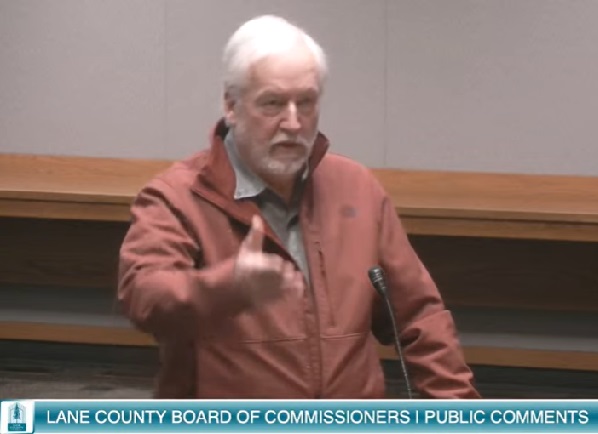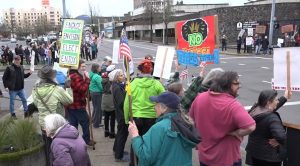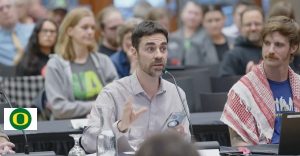Angry Egan volunteers demand answers from county
14 min read
In the aftermath of the ice storm, Egan Warming Center volunteers demanded answers from Lane County: Where was the county when the people of Springfield called for help? During public comment Jan. 23:
John F. Helmer: I’m John F. Helmer. I work at the Egan Center in Springfield. I come with really two messages. One is, thanks for what went well. And the other is a call to action to fix what needs improvement.
[00:00:26] In terms of what went well, I think it’s too easy to forget to thank the doctors and the nurses and the first responders, all the volunteers and staff of the nonprofits and many others, the utility workers who looked after each other, even neighbors, and made this storm no worse than it might have been. So those people need to be recognized first.
[00:00:50] But of course I want to focus also on what went poorly. And we know some things are going to take time and study in terms of the resiliency of the community, but some things are going to need to be addressed right away. So I’m coming to you, I hope, with something that you’ll see that is worked on immediately.
[00:01:06] At the Egan Centers in Eugene and Springfield, the victims of the storm came over the days, one after another, just continued to come. They walked in from camps by the river and they came in from homes that had been damaged by trees. They were people familiar with homelessness, but also people who had never been homeless before.
[00:01:27] Over time the situation became more and more untenable and dangerous. We got crowded, supplies dwindled, volunteers that worked 10-, 12-, 17-hour shifts were exhausted. And we couldn’t get new volunteers there. So this was a real danger to life and safety in the making. The leadership of St. Vincent de Paul, as I understand it, made calls.
[00:01:53] They made calls to emergency services in Eugene, in Springfield, in Lane County. Unfortunately, the victims kept coming, but the outside emergency help never arrived. In Springfield we came to the point where we needed to close, but we refused to do so and it’s a good thing. I was out there, I saw the ice, I know people would have fallen, broken bones, suffered hypothermia and stressed our already-stressed medical services.
[00:02:19] All of this happened two blocks from City Hall, where the doors were closed and locked. So while some things might take time, I’m here to make a call to action to quickly convene emergency personnel from Lane County, Eugene, and Springfield and to find out what went wrong, why our calls for help went unanswered.
[00:02:41] We have two months of winter left. This situation could happen again next week. So I’m calling for immediate assessment so that this failure and endangerment of life and safety never happens again.
[00:02:53] Charlotte Helmer: My name is Charlotte Helmer. (That happens to be my dad.) I’m a volunteer for the Egan Warming Center in Springfield. This is my first time giving a public comment, and I am speaking as an individual, not on behalf of Egan.
[00:03:06] Egan is a low-barrier, ad hoc shelter system that opens on nights when forecasted temperatures are below 30 degrees. I’m shift lead at Egan. That means that I focus on supporting my volunteers so that they have the greatest capacity to serve our guests. I try to uphold our protocols and keep everyone safe. During the ice storm, I saw our volunteers and guests struggling in unsafe conditions.
[00:03:32] Just halfway through the storm, we were already dangerously understaffed and no one was scheduled to relieve us. The shelter was overcrowded. The toilets were frozen and full and trash was piling up. We called county emergency management. We called the city emergency managers, LTD, law enforcement, and other public agencies.
[00:03:51] We called for backup. We really needed people to come staff the shelter immediately, or we needed transportation for our people to some other safe place, and no help came. I thought we were at the end, but my crew of volunteers refused to close the shelter. They turned on me, and I’m really glad they did.
[00:04:10] They said, even if we hand over the building to our guests and walk away, we cannot close. And they were right. Conditions in the shelter were risking life and safety, but conditions outside were the same. Slick ice, temperatures below 20, nowhere for vulnerable people to go. Following protocols to keep ourselves safe would have been viciously cruel to our guests.
[00:04:35] So we stayed open for another 31 hours. At times there were just four volunteers and over 140 guests in the building. Law enforcement kept bringing us storm refugees. The power failed. We kept going in the dark. We scrounged up flashlights and propane stoves. We treated wounds and frostbite with towels and trash bags.
[00:05:00] Volunteers pulled 8-, 12-, and 16-hour shifts. When Springfield City Hall finally opened, we broke a trail through ice so our people could reach their doors. I understand the purpose of closing services in a storm, of following protocols to protect city and county workers. But this was a true state of emergency.
[00:05:19] I am appalled and angry that public agencies at every level hid behind their protocols and left people to suffer and risk injury and death. Government leaders heard our calls for help and they gave us nothing. And if they tried to help, it was too little and it came too late. I wish that our community leaders could have been on shift with us during the storm, that someone had grabbed their attention and demanded that they take care of the most vulnerable people.
[00:05:43] We need an after-action review of how emergency services functioned and failed.
[00:05:47] John E. Helmer: Hello, my name is John Helmer, John E. Helmer, also his son. I’ve been a volunteer at Egan Warming Center for the past seven years. During the ice storm, in my view, we were abandoned. Rather than being the first line of defense, our shoestring operation was actually the only life-and-safety-preserving option for a huge portion of the most vulnerable people in our community.
[00:06:12] For the volunteers, as the ice settled in, it became increasingly clear that our normal schedule of closing the doors at 8 and forcing everybody out was simply untenable. The ice was still well over an inch thick. It would have forced 140 people out onto that ice with nowhere to go—people we have come to know and care about.
[00:06:31] And so we stayed open, ignoring our instructions, ignoring the basic and reasonable rules that our leadership had set out to keep volunteers safe. At this time, we knew that St. Vinny’s staff was working hard to get us relief workers, to keep the lights on, to get us food, and to try and address the overflowing port-a-potties that we relied on.
[00:06:51] St. Vinny’s staff were doing that, but the city and the county were nowhere to be found. I spent dozens of hours at the Egan Springfield site, and in that time, the only substantive aid we got was from St. Vinny’s. What I did see of my government was Springfield Police continuing to drop people off for us to take care of long after our site was supposed to be closed.
[00:07:10] They were relying on us for the most basic functions of government. I know of one occasion in which a person was released from the hospital at one in the morning in the middle of an ice storm, and when they would not leave for safety reasons, they were given the option of going to jail or going to an Egan Warming Center.
[00:07:27] That was the option. That was the answer that the police were able to provide for them.
[00:07:31] Let’s see. I worry that somebody will see the revolt of the shelter volunteers as a heartwarming story of neighbors coming together. That’s not what happened. As far as I’m concerned, local government decided to push people out on the ice and accepted the fact that some of them would die, many of them would be injured. And the people who had to do the pushing simply refused to do that.
[00:07:51] I personally spent more than 17 hours on Tuesday alone walking back and forth without a break, helping people wherever I could with no expectation of when I would be relieved.
[00:08:01] I’m angry. Not at the police or at anyone in particular, but at the fact that based off the outcome, it seems that our emergency response simply did not value the lives of these people.
[00:08:11] But I know that’s not what we want. That’s not what you want. And there are a lot of people who work very hard to make sure that our emergency response systems work.
[00:08:18] I speak in these stark terms because I think we must deal with these issues frankly. And I am hoping that we undertake a serious examination of how these systems fell apart and incorporate feedback and information from volunteers and homeless people who are the most vulnerable among us.
[00:08:35] And if they don’t get served by our emergency response, then it simply isn’t sufficient.
[00:08:39] Liz Hurkes: My name is Liz Hurkes. I am one of the morning shift leads at the Springfield Egan Warming Center.
[00:08:44] On Tuesday, Jan. 16, we planned on an 11 a.m. closure. But we stayed open until 3 o’clock the next day, because we realized that if we closed the doors at 11, that our guests would have zero community support in the still subfreezing temperatures and atrocious conditions.
[00:09:04] What I experienced in the Memorial Building on the 16th and 17th was awe-inspiring. We had a tiny crew of some of the most compassionate volunteers hanging on by a thread and working together to keep our doors open outside of protocol to ensure that our guests stayed safe and alive, all 145 of them.
[00:09:26] We did this without any help from the city of Springfield or Lane County, who in one way or another kept telling Tim Black, the Egan coordinator, that they were unavailable. What was awe-inspiring was also incredibly disheartening. I realized that I live in a community that seemingly does not have a basic plan in place to house and support our most marginalized neighbors during a natural disaster—that the city and the county relied on a tiny crew of volunteers to keep the most vulnerable, safe, and alive.
[00:10:01] We had overflowing and frozen port-a-potties. We were using headlamps when the power was out. We were using a camp stove set up to heat up water and soup. We were at capacity, we were over capacity in the sleeping room.
[00:10:14] And we kept making more space when law enforcement kept bringing us more people. I know that there are people applauding us for what we pulled off and it is a shame that we had to do it. Winter is not over and this will happen again someday.
[00:10:25] I would like the city and the county to step up now, to be prepared and proactive with a plan so that when it comes down to it again, there’s not volunteers in a crisis-situation emergency shelter doing the impossible with nothing, waiting hour by hour for the city and the county to offer support and realizing that y’all have nothing to offer. And I would like to know why nothing was offered this time.
[00:10:55] Fran Munkenbeck: My name is Fran Munkenbeck and I appreciate allowing me to speak at this meeting. As a volunteer at Egan, I saw not only that Egan gave shelter to people who were without a home prior to the ice storm, but people without days of electricity who could not find a hotel available or that they could afford. Some were dropped off by the police as they felt that they were too ill to stay in their home.
[00:11:19] Some were elderly and frail (I took care of a patient that was 81 at the time), some with babies and children, and the babies and children, Egan managed to find another safe site for them, so that they were cared for. The city did not help. Some were quite ill, and had to be urgently assessed at Egan. I’m one of the medical leads, and so a lot of times we do first aid, but sometimes we’re asked to urgently assess, and I did.
[00:11:47] Matter of fact, I think on Tuesday I sent two in one ambulance to McKenzie and one was very ill. We couldn’t find a blood pressure and neither could the paramedics, although this patient was still managing to talk. And that. So. I was at Springfield site, but heard that at Wheeler there was a public health issue such as portable toilets were overflowing and no one could get to the site to clean them adequately.
[00:12:13] The volunteers at Egan did an incredible job and they did it as it was the right thing to do. However, I, as a citizen who pays taxes, was shocked that it took till Tuesday afternoon for the government, for the governor to call a state of emergency in Lane County so that resources can be released for an emergency operation of what’s going on.
[00:12:38] I, Saturday, volunteered as part of the Medical Reserve Corps at Cottage Grove Community Center and talked to the Red Cross and asked them what it takes for them to start acting. And they said they get told by the Emergency Operations Center. But the Emergency Operations Center doesn’t happen until the governor calls a state of emergency.
[00:12:58] So somehow, I want to understand who locally speaks to the government about issues at stake so that they can make a more intelligent and timely decision. I feel the chain of command failed.
[00:13:11] David Strahan: Thank you for this opportunity to speak. My name is— …I’m sorry. This has been a rough week. Thank you for this opportunity to speak. I live in East Thurston, one of the areas hardest hit. I’m also a long-term Egan volunteer, site lead, site manager. I was parked every day, overnight, for many hours at the Egan Warming Center.
[00:13:37] And I can attest to everything that our volunteers have said, and more. There’s a lot that’s not being said. Obviously, we want to know where our public was, where our representatives were, where the city help was, where the help was for a town of 61,000 people to have a shelter with 150-person max, understaffed, low on hygiene, low on food, with no power.
[00:14:05] When the power went out that last night, it was epic. Our volunteers rallied, our guests rallied, and the older couples that we had in our facility felt safe and warm. Some of those couples still have not returned to their home, and they’re in various shelters around this town.
I, too, would like a debriefing of what happened, of where the systemic failures were in our shelter system, and why we haven’t hardened some of our local schools to have resources available for us 61,000 people when there’s only one shelter ran by volunteers, it maxes at 150, when properly staffed, with proper sanitation, with power, with food.
[00:14:49] We have the capability within this community to solve this problem. What we need is the collective will from our leaders. We need our main thoroughfares marked as emergency routes and given priority for clearing.
[00:15:05] We need key schools and infrastructures like the Bob Keefer Center available, with backup generators, with emergency supplies on hand, with local residents available to start that center’s opening. (I) look forward to more comments and more improvements in our system as both myself and all the volunteers in Egan—and in fact, all of the citizens—come together for a better reaction to the next emergency.
[00:15:32] We are super fortunate that we didn’t happen to have an earthquake or some other natural disaster. Time was on our side. We knew that if we could wait this out, that we would survive. Sadly, through this emergency, some of our residents will not survive.
[00:15:47] We have yet to know the final count, but we need something better than a cadre of volunteers to solve this problem. We need our county’s help.
[00:15:56] John Q: Volunteers ask: Where was Lane County, when its residents needed them most?
All speakers emphasized that they were speaking as individuals and not as representatives of Egan Warming Centers or St. Vincent de Paul of Lane County.
Lane County commissioners also received the following public comment from Dr. Malori Musselman:
Hello Commissioners,
My name is Dr. Malori Musselman and I live in District 2. My comments are my own and do not reflect the positions of Egan or St. Vinnies. I also want to recognize and thank the utility and tree workers, fire department and EMS, CAHOOTS, support and hospital staff, and other workers that continue to toil long hours for this community. We need you.
I am here to testify to what I saw as a breakdown of communication and coordination in emergency response—risks to public health, life, and safety—especially as that pertains to our homeless neighbors or those made homeless by storm damage and subsequent power outage.
On the morning of Jan. 16, when I arrived for my 5:30 a.m. shift at Egan, we had more than double the amount of guests that we usually prepare for and the conditions outside were worsening by the minute. In good conscience, we felt we could not simply close our doors and force people out into these horrific freezing conditions—especially as no public buildings were open.
Some of our guests had struggled through the ice for miles—arriving in the first stages of frostbite, some had been taken from their homes by the Springfield Police Department and dropped off at the center after our operating hours, and while we only serve adults, families arrived with their children in extreme distress.
I have known many of these guests for years. They have lived in this community far longer than I have. And they all felt there was no plan for them. They felt abandoned outside of us—this group of rogue volunteers occupying a derelict building which also lost power and was provided no generator despite our pleas to several agencies to help us save the lives of the more than 150 people in the building. Instead, we stayed open into the next afternoon as we the volunteers brought camp stoves, headlamps, and propane to try and at least cook hot meals for people.
This inhumane response to a disaster must never happen again. I am asking that the county move immediately to begin a debrief and identify what aspects of emergency management went wrong and to act immediately to remedy these breakdowns. This or some other disaster will happen again and we need to have a coordinated plan to respond.
That plan cannot rely on a few exhausted individuals to keep our community alive and safe. I want you all to understand that this could have been you and I would like you to think about how we should care for human life in a crisis.
I know that a handful of freezing guests started a warming fire under City Hall that caused the building to be evacuated. The symbolism was clear: Sometimes we need to light a fire under our governments to do better—because we deserve better.
Thank you.
Dr. Malori A. Musselman





